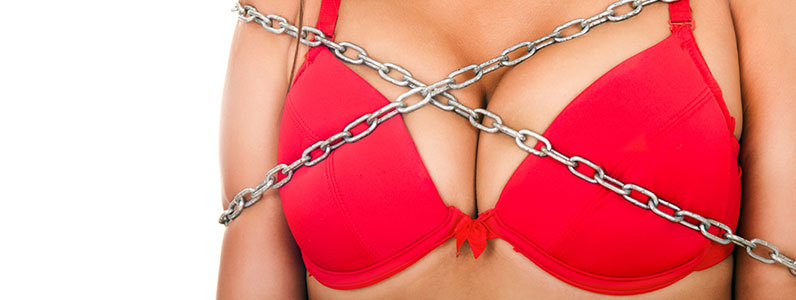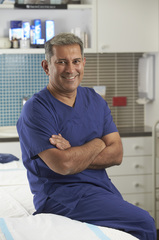
Struggling with Big Boobs ?
The majority of discussions on cosmetic breast plastic surgery seem to focus on women who want implants or augmentation: types of implants, improved implants or replacement implants. Basically, for those women who want bigger breasts, so they can feel more comfortable with their femininity. What about those of us who struggle with naturally big (in some cases, really big!) breasts though? Those who have spent a lifetime trying to accommodate them and who, as opposed to the majority of breast surgery patients, would prefer not to attract the unwanted attention usually afforded to those with a big bosom! Don’t we deserve the opportunity to feel comfortable with our sense of femininity too? We referred to Dr Mark Hanikeri, Specialist Plastic Surgeon from Western Australia to contribute his knowledge on the benefits of a breast reduction and what other issues can be associated with having breasts too large for our frame.
Dr Hanikeri says, “Many women suffer from symptoms that they do not even realise are related to having large breasts. Symptoms include neck ache, back ache, shoulder pain, problems with bra straps which cut into the soft tissues of the shoulders and neck, rash underneath the breasts and social embarrassment.”
Whilst some women feel envious of large breasted women, these symptoms of being top heavy can really make every day life uncomfortable – painful even. Finding clothes that fit properly can be a nightmare. When your waist is a size 8 or 10 but your breasts are a size 14 or 16, dress shopping becomes torture. Whether you are looking for that ‘just right’ outfit, it can be hard to find a dress that will fit comfortably or look right and they can make your breasts look like a couple of escapees on the edge of a prison wall, if they fit in the dress at all!
As Dr Hanikeri mentions, there is also often pain, real pain, in having larger breasts. Whether a bra is fitted correctly or not, the weight of a woman’s breasts can cause severe back, shoulder and neck pain. Furthermore, the weight coincided with an ill fitting bra can cause sores along the strap lines and under the breasts. These sores are painful and can be embarrassing, perhaps made worse during menstruation when breasts are inclined to become more painful due to swelling. Participating in sporting events, whether professionally or socially, can be extremely uncomfortable and painful, or even impossible, despite the most advanced design of sports bras. Then there is ‘The Clap’. That awkward moment when you roll over in bed next to your partner and one breast lands against the other – ‘Clap’. It sounds like an electrical storm from the Indian Ocean has just landed in your cleavage! Some women even go so far as to wear their bras to bed.
So, this leads many women to consider having a breast reduction. Not only to discourage the unwanted attention, but to alleviate the pain and to live a life that doesn’t revolve around giant, heavy boobs. Dr Hanikeri tells us, “Bilateral breast reduction is a procedure which has a very high satisfaction rate related to correction of all of these symptoms in most cases.
The procedure is performed under a General Anaesthetic and whilst there are a variety of techniques which apply, the majority result in very acceptable scars and a nice shape to the final breasts. In most cases the shape of the breasts after breast reduction is aesthetically far superior to that before breast reduction.
Breast reduction is appropriate for women whose breasts are a double D cup or greater and who have any of the symptoms mentioned above. Ideally women should be at a reasonably healthy body weight and the procedure is usually only offered to those whose BMI is below or around 30. It is generally not offered to smokers, though it can be offered to those who have stopped smoking for at least four weeks.”
Larger breasts may also cause sagging and therefore breast reduction surgery involves a breast lift at the same time. There isn’t a particular age restriction on having a breast reduction and post menopausal women are among those whose breasts often continue to grow after taking Hormone Replacement Therapy (HRT), as breasts are sensitive to the hormone oestrogen. Those of adolescent age are advised to wait until their breasts have finished growing to avoid having to repeat the procedure at a later date. As Dr Hanikeri advises, if you are overweight, it is advised to diet and exercise to lose some weight before the operation as dramatic weight loss after the reduction may change the shape of the breasts. Having said this, it is sometimes hard to lose weight through exercise though when it can be painful to do so with breasts that are large and uncomfortable.
What does a Breast Reduction surgery involve?
The most common technique of breast reduction is to make incisions in the breasts and surgically remove fat, glandular tissue and skin. Once the required amount of tissue is removed the breasts are reshaped and the nipples are repositioned. The time taken for this procedure can be between two to three hours under general anaesthetic. Scarring varies with the technique but there is a visible circle around the nipple and areola with a line leading down under the breast. There may also be a scar in the fold under the breast. As would be expected, bruising develops on and around the breasts and soreness may be experienced for several weeks and maybe months after the operation. Complications may derive from the healing of the wounds and there may be loss of nipple sensation. Breastfeeding after having breast reduction surgery may be affected. Speak to your surgeon about this before you undergo your surgery. However, the majority of women consider these side effect risks to be a small negative against the many positives of having the operation and generally the scar becomes quite acceptable. Dr Hanikeri says, “The scars from breast reduction take some time to settle down, but in most cases after 12-18 months are very inconspicuous.”
Another technique becoming more widely popular is Microlipo breast reduction surgery. This involves no cutting and therefore no scarring and can be done under local anaesthetic. A tiny incision is made and a cannula is inserted into the fat cells below the skin. The cannula then breaks up the fat cells and draws them out. The recovery time is considerably less. However, Microlipo is not suitable for everyone as it only removes fat cells without taking into account any loose skin that may need to be removed in order to correctly reshape the breast after reduction. It may also cause the similar issue of nipple numbness.
Whichever technique is undertaken, the majority of women enjoy the overall benefits of having breast reduction surgery. As well as making women more confident in their own skin, it becomes easier to exercise, find the right fitting clothes and perhaps best of all – ‘The Clap’ becomes a thing of the past!
Is Breast Reduction Surgery Covered By Medicare?
Dr Hanikeri specifies this on his website: “Medicare rebates do apply for breast reduction and if the patient has private health insurance, then some of the cost of the surgery, anaesthetic and hospital stay may be covered.”
For more information or to request a consultation with Dr Mark Hanikeri, you can call his secretary on (08) 9380-0311
Further Reading about Breast Reduction Surgery
- Breast Reduction Surgery in Sydney with Dr Kernohan
- Reduction Mammoplasty (Breast Reduction) – Dr Jake Lim
- Can I Use My Super For My Plastic Surgery?
- Breast Reduction by Dr. Guy Watts | Plastic Surgeon Perth
- Breast Reduction Sydney – Soliman Plastic Surgery
- Breast Reduction Melbourne by Dr Carmen Munteanu FRACS (Plas)

